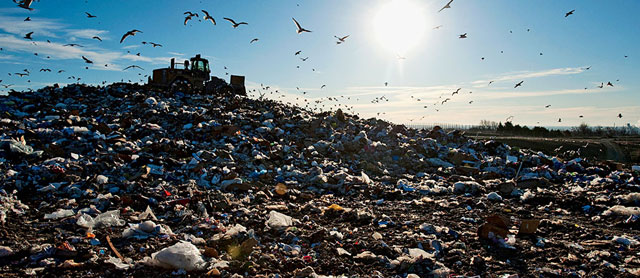sierraclub.org - sierra magazine - march/april 2012 - grapple: garbage in, garbage out
Garbage in, Garbage out | Charismatic Microfauna: Tardigrade | Burning Plastic |
Shrinking Arctic Ice | Hendra Virus | Up to Speed
GARBAGE IN, GARBAGE OUT
Time to recycle the "Trash Bible"?
By Edward Humes

The citizens of Lincoln, Nebraska, toss nearly twice as much garbage as the EPA thinks they do. | Joel Sartore/National Geographic Stock
Everyone thinks they know how much trash Americans throw away. The official EPA figure—used by environmentalists, businesses, and policymakers—maintains that the average American rolls just over 4.3 pounds to the curb every day. About a third of that gets recycled, with the rest going to landfills. The numbers are found in the agency's exhaustive annual compendium Municipal Solid Waste in the United States—the EPA's "Trash Bible."
The problem is that the gold standard of garbage is wildly wrong, leaving 140 million tons of refuse unaccounted for. Americans actually throw out more than 7 pounds a day, sending nearly twice as much waste to landfills as the EPA lets on. An obscure but far-more-accurate annual survey made jointly by Columbia University and the trade journal BioCycle does what the EPA hasn't: actually count our trash using real-world data from the nation's landfills.
The EPA relies largely on industry-provided data on product sales, estimating how quickly those products wear out and get thrown away. Its method was developed decades ago when there were eight times as many legal dumps, many more illegal ones, and little good data available. That picture has changed: There are now far fewer landfills, and most of them carefully weigh each incoming candy wrapper—their pay-by-the-ton business model depends on it.
The Columbia-BioCycle surveys also reveal that Americans recycle or compost proportionately far less than the official stats suggest: not the third of our total trash estimated by the EPA—a milestone we were supposed to have surpassed a decade ago—but less than a quarter.
Nickolas Themelis, director of Columbia's Earth Engineering Center, is one of the trash cognoscenti calling for reform of this "untenable situation." Among myriad problems created by the incorrect data, he frets, is the false impression that current waste-reduction strategies are working. He argues that the United States needs to follow Europe's lead: The Netherlands, Germany, and Sweden have all but eliminated landfills by combining strong recycling programs with a new generation of low-emission waste-to-energy plants. (See also "The Next Big Thing")
Even the EPA recognizes the flaws in its Trash Bible. The agency department responsible for estimating greenhouse-gas emissions from U.S. trash, in fact, has for the past four years relied not on the EPA's official figures but on the Columbia-BioCycle surveys.
Edward Humes is a frequent Sierra contributor. His new book, Garbology: Our Dirty Love Affair with Trash, will be published in April by Avery.
Charismatic Microfauna: The Tardigrade